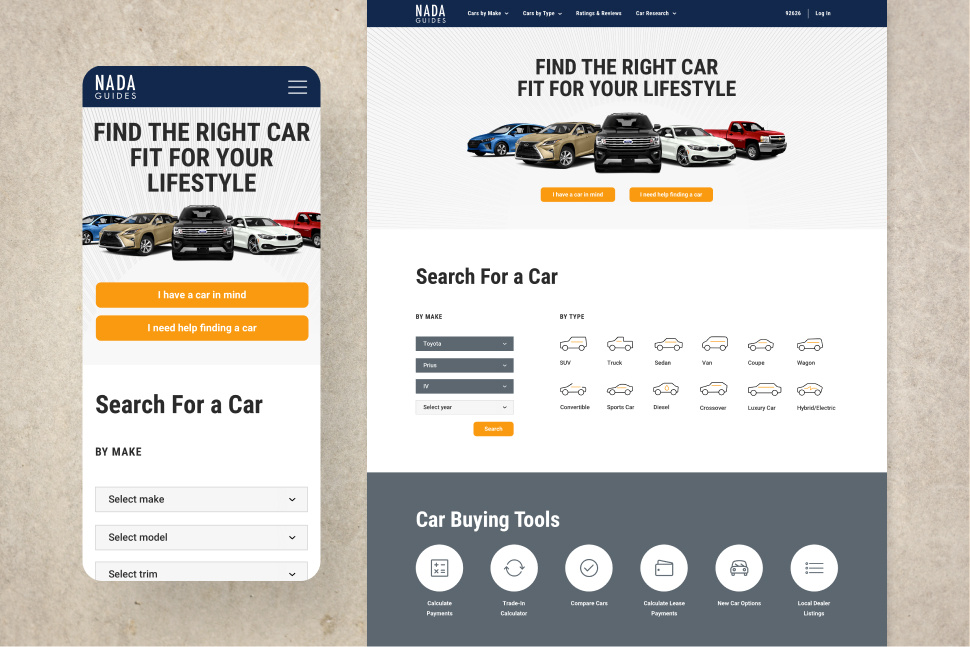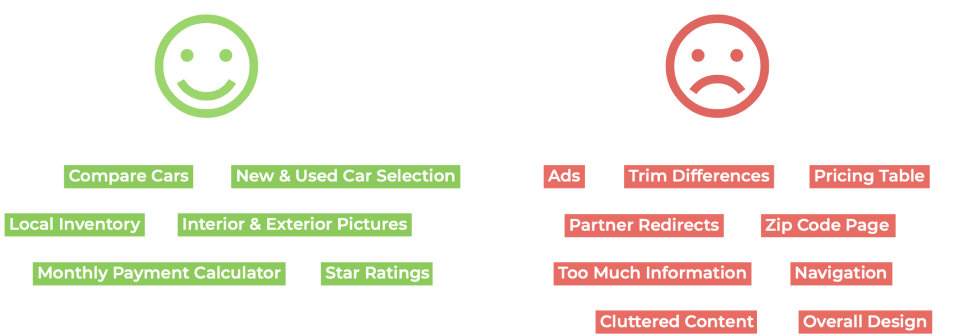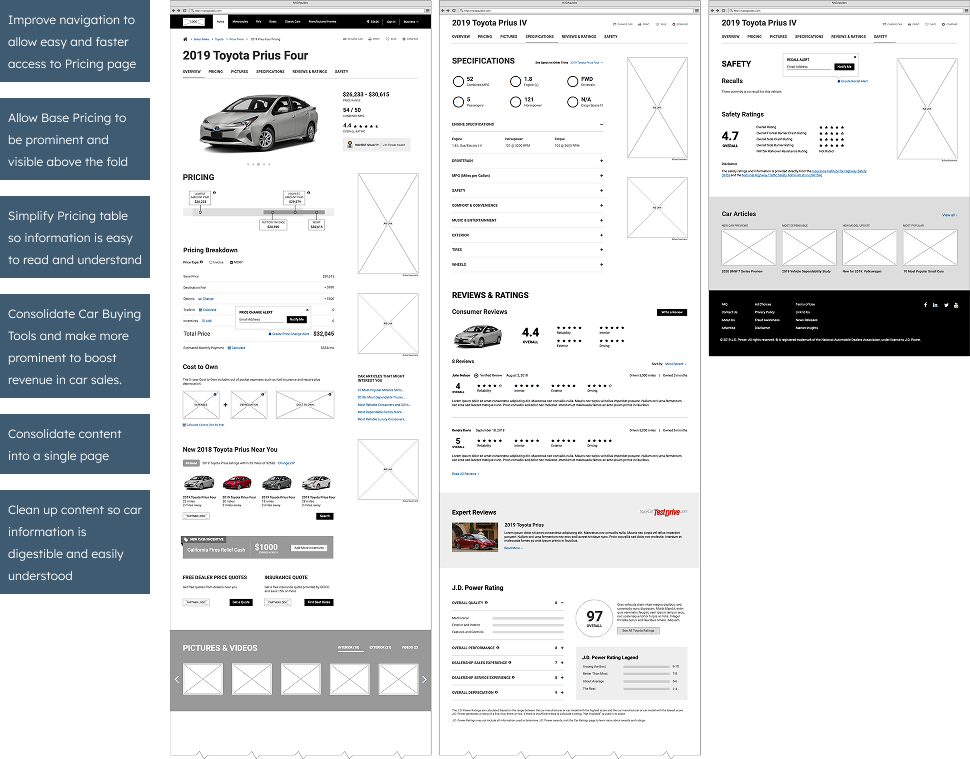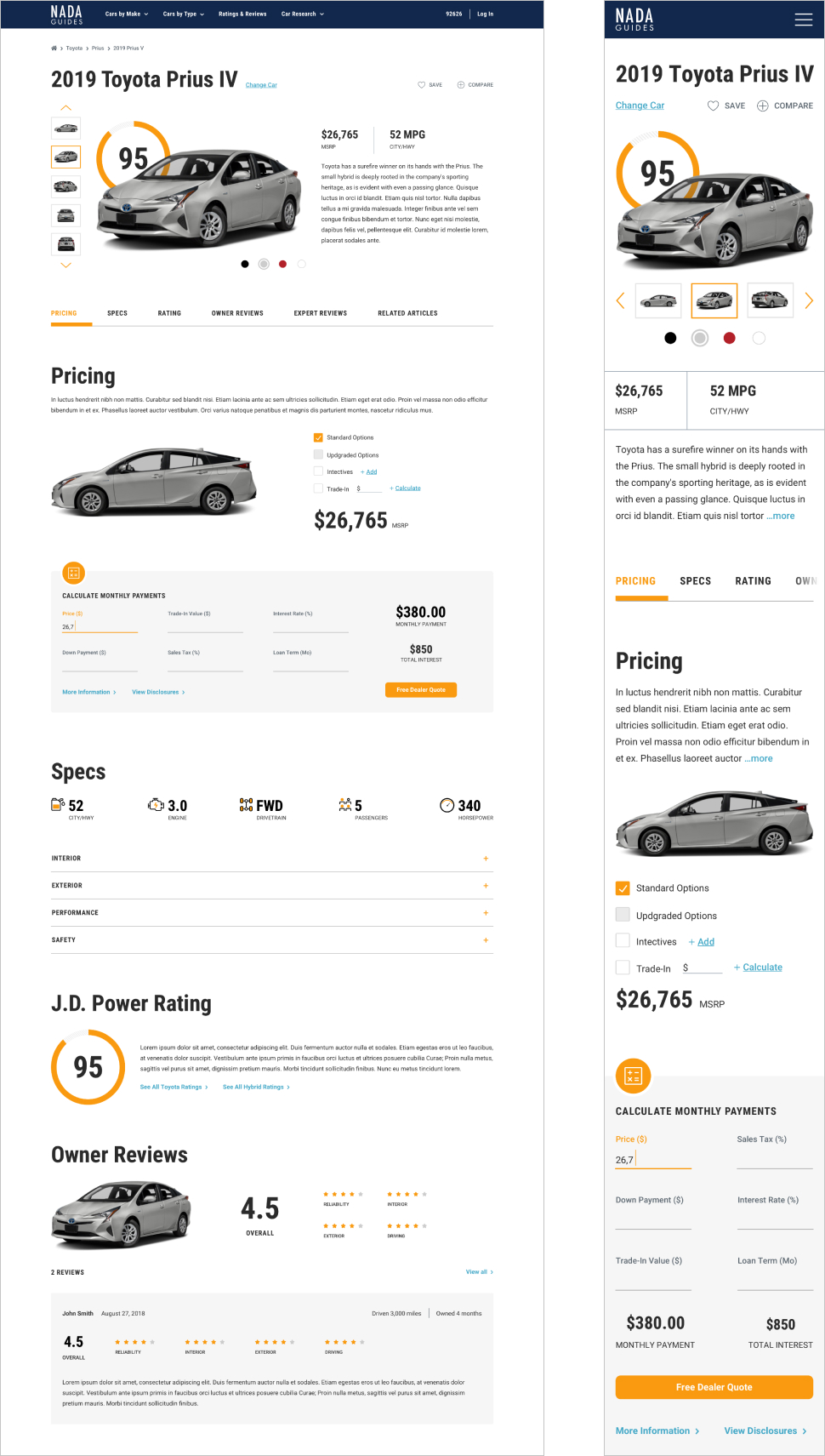NADAGuides
Automotive, E-Commerce
Transforming revenue model while elevating user experience

ROLE: UX Research, UX Design, UI Design, Design Leadership
METHODS: Survey, LoFi Wireframe Creation, Prototyping, User Flow Design, HiFi Mockup Design, Task Analysis, Usability Testing, Data Synthesis, Design Pattern Standardization
TOOLS: Adobe Analytics, Onsite Survey, Mural, Balsamiq, Sketch, Validately
TEAM: UX Research and Design teams
Business problem & context
After J.D. Power's acquisition of NADAGuides (a leading vehicle data publisher), our organization sought to combine both sites into a single, powerful product. Analytics revealed alarming bounce rates of up to 75% on NADAGuides' income-generating vehicle search paths, directly impacting business revenue. The existing ad-heavy strategy was creating tension between business needs and user experience—a classic problem in content-rich, ad-supported platforms.
The business challenge was significant: How could we redesign the experience to improve user engagement while simultaneously addressing revenue requirements? This tension between ads and user experience represented both a threat to the combined brand's reputation and an opportunity to pioneer a more sustainable business model.
My role & leadership
As Lead UI/UX Designer for the Consumer Division, I spearheaded the transformation strategy that would fundamentally redefine NADAGuides' approach to balancing revenue generation with user experience. My leadership extended across several dimensions:
- Challenged the prevailing "more ads" mentality by presenting comprehensive data showing the correlation between ad saturation and user abandonment
- Orchestrated research initiatives involving over 9,000 survey responses and targeted usability testing
- Developed a dual-track implementation roadmap that addressed both immediate pain points and long-term strategic objectives
- Built consensus among business stakeholders by creating a compelling vision showing how improved user experience would drive sustainable revenue growth
- Led design teams in reimagining key user journeys while maintaining sensitivity to revenue requirements
Strategic approach
I developed a nuanced transformation strategy that moved beyond the false dichotomy of "user experience versus revenue" to find innovative solutions that served both imperatives:
- Deep quantitative analysis: Collaborated with Audience Acquisition team and leveraged Adobe Analytics data to pinpoint exactly where and why users were abandoning revenue-generating paths
- Voice of customer integration: Conducted extensive onsite surveys (9,156 responses) revealing that while 74% of users found value in our content, 65% struggled to access basic information
- Journey optimization: Used usability testing with realistic scenarios to identify specific friction points in the vehicle search experience
- Strategic segmentation: Collaborated with the Development team and distinguished between "must-fix" issues for the MVP and more comprehensive changes requiring full redesign
- Revenue model innovation: Created proposals for transitioning from purely ad-supported to a more diversified model incorporating partner revenue and premium services
Rather than approaching this as a design refresh, I positioned it as a fundamental business transformation—one that would create a more sustainable revenue model while dramatically improving the user experience.
Key research insights
Our multi-method research approach yielded several critical insights that drove our strategy:
- Users spent an average of 6 minutes completing basic vehicle research tasks—far longer than competitive benchmarks and a clear indicator of unnecessary friction
- The correlation between ad placement and abandonment was strongest at key decision points in the user journey, suggesting users were leaving precisely when they were most valuable
- Comparison tools received overwhelmingly positive feedback, yet were underutilized due to discovery challenges
- User verbatims consistently highlighted the intrusive nature of ads as their primary frustration, with comments like "I can't find the information through all the ads" appearing repeatedly
- Search path analysis revealed that users often abandoned journeys after encountering the third or fourth ad—indicating a clear threshold of tolerance
These insights enabled us to precisely target interventions where they would have maximum impact on both user satisfaction and revenue preservation.

Key design decisions
Armed with compelling research, I made several transformative design decisions:
- Strategic ad integration: Reimagined ad placement to focus on quality over quantity, positioning fewer, more relevant ads at natural pausing points in the user journey rather than interrupting critical tasks
- Progressive disclosure model: Implemented a more intuitive information architecture that presented vehicle information in logical layers, reducing cognitive load while creating more organic opportunities for monetization
- Enhanced comparison functionality: Elevated the highly-valued comparison tools to a more prominent position in the navigation, significantly reducing the steps required to access this feature
- Partner integration framework: Designed a system to seamlessly incorporate partner offerings (financing, insurance) as value-added services rather than disruptive advertisements
- Personalization layer: Created functionality to remember user preferences and vehicle interests, improving the relevance of both content and monetization opportunities
The most significant challenge was shifting stakeholder perspective from viewing ads as a volume business to seeing them as part of an integrated experience strategy. By demonstrating how strategic ad placement could maintain revenue while dramatically improving engagement, I created a compelling case for transformation.

Results & business impact
Our transformation strategy delivered measurable improvements across both user experience and business metrics::
- MVP implementation reduced bounce rates on key vehicle search paths by 20% within the first month
- Strategic ad placement maintained 85% of ad revenue while significantly improving user satisfaction scores
- Site engagement metrics showed a 35% increase in pages per session following the initial improvements
- Follow-up surveys revealed a 40% improvement in user satisfaction with information accessibility
- The long-term redesign established a foundation for diversified revenue streams that reduced dependence on display advertising
